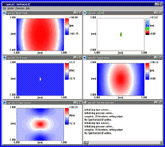
MicroPhysics
TapeLab
TapeLab
is a numerical simulation of the head/tape interface that was
specifically designed for use in longitudinal tape recorder
configurations. The simulation combines non-linear equations for
compressible air bearing, tape mechanics, and tape contact with the
head.
The finite element method is
used to solve these coupled non-linear equations. TapeLab
predicts head/tape spacing and contact pressure between the head and
tape. TapeLab also contains a wear model that allows the
prediction of head contour after wear with a specific tape. The
head/tape interface can be investigated using different tape thickness
specifications.
TapeLab is divided
into two versions. TapeLab1 is a one-dimensional program, which
calculates spacing, contact pressure, and headwear along the tape
length only. Tape width is assumed to be infinite; therefore, effects
due to partial slots in the head and the tape edge can not be
simulated. In these cases, TapeLab2 is required.
- Flat Sections
- Cylindrical Sections
- Final Head Contouring by
Numerical Simulation of Tape Lapping
Alternatively, the head can be
specified by a user supplied file of nodal values which indicate head
protrusion.